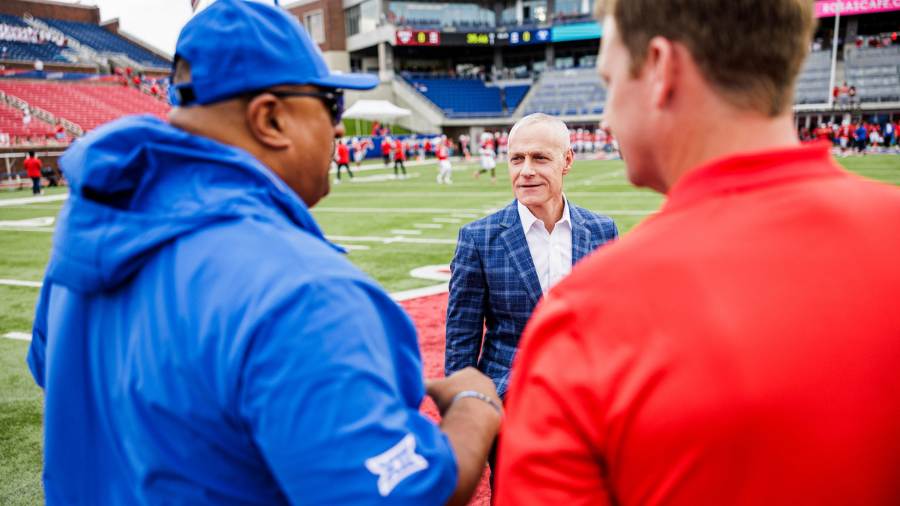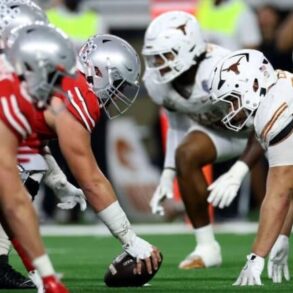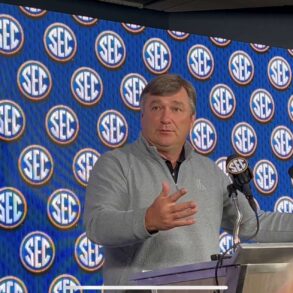
ORLANDO, Fla. – The Big 12 Conference is taking its Spring Business Meetings to the most magical place on Earth.
Walt Disney World, specifically the Waldorf Astoria near the magical parks, will host the annual spring event on the Big 12 calendar.
This year’s spring business meetings will again bring Commissioner Brett Yormark, the school Presidents and Chancellors from the 16 Big 12 institutions, athletic directors, and women’s basketball coaches to Orlando.
Along with a new location away from Irving, Texas, where the league headquarters reside, the other new wrinkle to this year’s meetings is that football and men’s basketball head coaches will also attend.
In previous years, the Big 12 football and men’s basketball coaches held their annual coach meetings in Arizona at the Fiesta Summit.
So if you’re staying at the Waldorf Astoria for a Disney World vacation this week, you might see Kalani Sitake mingling in the hallways with Kyle Whittingham, or second-year basketball coaches Kevin Young (BYU men’s) and Gavin Peterson (Utah women’s).
The new in-state coaches at the Big 12 meetings include BYU Women’s Basketball head coach Lee Cummard and Utah men’s basketball coach Alex Jensen. Both were hired by their alma maters earlier this spring.
Big 12 Spring Meetings kick off on Wednesday morning, and there’s no shortage of storylines to monitor.
College Football Playoff format
The College football world is buzzing about the future of the College Football Playoff format in 2026 and beyond.
We know that the College Football Playoff will be a 12-team, straight seeding model for the 2025 season, with the five highest-ranked conference champions receiving automatic bids.
After 2025, it’s anyone’s guess how it turns out.
There is a reported “memorandum of understanding” that the SEC and Big Ten have decision-making power to establish the next Playoff format beginning in 2026.
Ross Dellenger from Yahoo! Sports reported that the SEC and Big Ten are “directed to have ‘meaningful consultation’ and collect ‘input’ from the other conferences and TV partner, ESPN.”
The latest format gaining steam is a 16-team model that gives four automatic bids each to the SEC and Big Ten, then another two bids each to the Big 12 and ACC, with one to the Group of Six, and three at-large bids.
Another possibility is five automatic bids for conference champions plus 11 at-large bids.
Does the Big 12, which produced one bid in league champion Arizona State last year, have any alternatives besides accepting whatever the Big Ten and SEC put out there?
SEC Commissioner Greg Sankey, who hasn’t publicly endorsed a specific Playoff format, generated headlines on Memorial Day night when he spoke to reporters in Destin, six hours east of the Big 12’s meetings, when he took offense at the idea of creating a Playoff for “the good of the game.”
Big 12 Commissioner Brett Yormark and ACC Commissioner Jim Phillips each shared comments to CBS Sports’ Brandon Marcello after the straight-seeding model was adopted for the 2025 season. Both of the comments praised what’s good for college football.
Sankey on Monday in response to that, “You can issue your press statement, but I’m actually looking for ideas to move us forward.”
The Big 12 never issued a press release regarding the straight-seeding model in this year’s College Football Playoff.
It definitely appears to be an emotional topic, and the Big 12’s football coaches are likely to discuss it extensively.
Revenue Sharing / Future of NCAA enforcement
One year ago, when these Big 12 meetings occurred, the NCAA agreed to the $2.75 billion settlement, which would usher in the Revenue Sharing era. This would allow institutions to pay their athletes up to $20.5 million.
That $20.5 million comes from television media rights money, ticket sales, bowl and championship distributions, and other revenue streams.
A year later, the settlement has not yet reached a final approval as it remains with U.S. District Judge Clauida Wilken.
It’s a new era of college athletics, and there’s still no final decision on the matter.
Along with revenue sharing, how the NCAA enforcement is handled will be a big storyline. NCAA leadership is expected to attend the Big 12 meetings.
Transfer Portal windows
Since it opened in 2018, the NCAA Transfer Portal has been a hot topic in college athletics. While player movement is part of the game these days, the pressing issue now is when players can enter the Transfer Portal.
That brings us to Transfer Portal windows, the time in the calendar when players can enter the portal for a respective sport.
Football has two windows: one in December, when programs prepare for the College Football Playoff and Bowl Season, and the other in April, typically after schools conclude spring practices.
College football’s April transfer portal window single-handedly caused many programs to cancel spring games and public access to their teams altogether in the spring over fear of other schools poaching players.
For college basketball, the portal opens during the NCAA Tournament. BYU head coach Kevin Young told KSL Sports in April that he had to take calls with potential transfer portal targets in preparation for his team’s Sweet 16 matchup against Alabama.
Should there be only one window in football, similar to basketball, but have it happen in January? Could basketball move its one window to April after March Madness concludes?
It might take some Disney magic to resolve all the topics that are likely on the agenda for this week’s meetings.
Mitch Harper is a BYU Insider for KSLsports.com and hosts the Cougar Tracks Podcast (SUBSCRIBE) and Cougar Sports Saturday (12–3 p.m.) on KSL Newsradio. Follow Mitch’s coverage of BYU in the Big 12 Conference on X: @Mitch_Harper.
Want more coverage of BYU sports? Take us with you wherever you go.
This post was originally published on this site be sure to check out more of their content.









